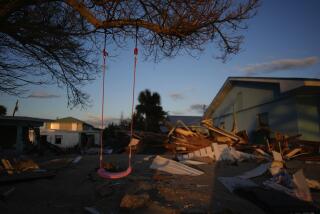Florida Declares Emergency Over Its Worst Freeze
MIAMI — Gov. Robert Graham declared a state of emergency in Florida on Tuesday as citrus growers grimly awaited the third straight night of the worst freeze in Florida history, a chilly nightmare that has brought the state some temperatures lower than those in Alaska.
Most of the state’s 30,000 citrus growers have yet to recover from the “once-in-a-century” freeze that hit the groves just 13 months ago, costing the industry an estimated $840 million. This week’s plunging thermometer readings threaten their trees as well as their crops and will require a long climb back to profitability.
Close Monitoring
“The state is closely monitoring the situation on an hour-to-hour basis, and we will be providing whatever assistance we can,” Graham said.
Nationwide, the massive cold wave was blamed for at least 126 deaths as it depressed temperatures again Tuesday. More than two dozen record lows for the date, all above zero, were tied or broken from Tennessee to Florida and Louisiana.
Cities with record lows included Chattanooga, Tenn., 5 degrees; Birmingham, Ala., 10; Charleston, S.C., 14; New Orleans, 22; and Savannah, Ga., 17.
In hard-hit Florida, Earl Wells, spokesman for the Florida Citrus Mutual, the state’s largest association of growers, said: “We have severe fruit damage, and there’s nothing to do but salvage what’s left on the trees.”
Frenzied Harvest
About 90% of Florida’s orange crop is used for juice concentrate. The current cold spell--with temperatures plunging to 6 degrees in Tallahassee, 19 in Orlando and 28 in Miami--calls for a frenzied harvest. The fruit can still be used for juice if it is picked quickly.
“When the orange freezes, the juice expands and breaks the sacs inside the fruit,” said Stanton Reese, a grower near Tampa. “Gradually, the juice evaporates through the outer wall. You need to get it within a week or take some loss.”
More troublesome for the grower than frozen fruit is the likelihood of dead trees.
“It’s the difference between having a flat tire and losing the entire car,” said Dr. Evan Drummond, assistant dean of the University of Florida College of Agriculture.
A citrus tree matures five years before it produces fruit. In the Christmas freeze of 1983, growers lost 120,000 acres of groves, or 12 million trees.
Replacing that stock was slowed last fall when canker, the disease most dangerous to citrus, was discovered in several Florida nurseries. Millions of seedlings had to be destroyed.
Other freeze-damaged trees were “hat-racked”--pruned until they only had three or four limbs. Those trees are most vulnerable to the latest frost.
“It’s like taking a 50-year-old man and cutting his arm off. He can survive, but if you come back 13 months later and cut off the other one . . . “ said Carl Reynolds, a grower from Deland who expects to lose 90% of his trees.
Art Mathias, general manager of the Haines City Citrus Assn., said: “A lot of them that pruned back will be looking at a dead grove.”
However, it will take three to six months before growers know the extent of their tree damage.
“Last time, some of mine looked like they were coming back strong, but it just turned out to be a final gasp,” Reese said.
Vegetable Industry
For now, state assistance to growers largely involves increasing the weight permitted for trucks transporting produce. That will help growers move the fruit to processing plants.
The freeze in Florida also has affected the winter vegetable industry, including the cabbage near Hastings; the tomatoes, limes and mangoes west of Miami; the radishes and cauliflower around Zellwood; and the lettuce near Belle Glade.
“The damage was severe,” Bernie Hamel of the Florida Fruit and Vegetable Assn. said. “That ought to bring prices up for the consumer, though a lot depends on what comes in from Mexico and other areas.”
In contrast to Florida’s freezing temperatures, Juneau, Alaska, had a low of 39 degrees and a high of 43.
The Associated Press reported widespread crop damage in southeast Georgia, including damage to bark on peach, apple and pecan trees.
“That is a concern” because split bark increases the danger of losing the tree itself, said Christine Thompson, spokeswoman for the Georgia Agriculture Department. “Then you’re talking about not just the crop for one year.”
In New York, Buffalo was still digging out from deep snow that had stranded truckers since the weekend. Schools remained closed in 28 counties in Michigan because of icy or snow-covered roads, though temperatures rose to the 20s.
Crews resumed work to clear the runways at Buffalo’s airport, but airport officials did not know when flights would resume as wind kicked up the snow.
Traveler’s advisories were posted for parts of Ohio, Pennsylvania and New York because of snow.
New York Gov. Mario M. Cuomo declared a state of emergency in Erie, Orleans, Wyoming, Genesee and Niagara counties, allowing for state assistance in snow emergency operations.
Residents of Gladeville, Tenn., were warned that more than 2,000 homes may be without water today because persons alarmed by freezing temperatures were leaving faucets running to keep their pipes from freezing.
“It’s all upside down,” said Harry Gordon at the National Severe Storms Forecast Center in Kansas City, Mo., noting that the temperature at International Falls, Minn., often the nation’s coldest spot, was 3 degrees warmer than the 9-degree reading early Tuesday at Nashville, Tenn.
Times researcher Lorna Nones assisted with the reporting of this story.
More to Read
Sign up for Essential California
The most important California stories and recommendations in your inbox every morning.
You may occasionally receive promotional content from the Los Angeles Times.










